Heating the house: which system to choose
In the construction of private houses in a mandatory manner must strictly comply with the building codes, enshrined in industry regulations and rules. Particular attention should be paid to this issue if you design your own home heating: the Russian Federation, like other countries, does not allow to operate engineering systems that do not meet the established standards. Therefore, before starting work it is recommended to familiarize yourself with the important theoretical information outlined below.

Varieties of heating systems
Before you install the heating in the house with your own hands, you need to choose a suitable type of climate network for your case. Without this, it is impossible to find the right boiler, buy pipes, radiators, fittings, valves and other materials that may be needed in the work.

Also, the amount of expenses for the design of the system, which it is advisable to calculate in advance, depends on how the houses will be heated.
There are several of the most popular ways to do home heating at home:
- install popular water heating;
- install an extremely rare steam heating system at home;
- to construct an air climatic network, eliminating the hassle of freezing water and quickly heating the house;
- use as a source of heat electrical devices.
Note! Each of the above heating methods requires the purchase of different energy sources. Therefore, when choosing a project, it will be useful to calculate the cost of heating a dwelling in the winter period. Of course, there is also free heating - with the help of solar energy - however, such systems are still under development and are not widely used.
The instructions below will tell you about the main elements, advantages and disadvantages of various heating systems. Having familiarized with it, you will be able to independently choose and arrange home heating with your own hands.
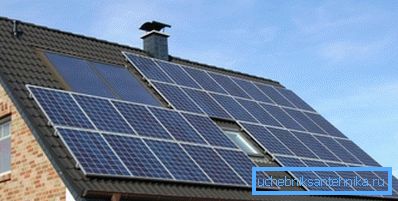
Water Climate System
Water heating for the house consists of a heating boiler, radiators, heating the air in the room, and pipelines connecting all the elements of the system into one. The system circulates the coolant - water or antifreeze - necessary for the transfer of thermal energy.

The main element of the system is the boiler. The most common models of heating units, with which you can organize heating in your home, are shown in the table.
| View | Description |
| Gas | Widespread option. The popularity of gas heating boilers is due to the low cost of operating the finished heating system, as gas is one of the most inexpensive types of fuel. However, such a device can be installed at home only with the permission of the relevant monitoring services and provided that a gas pipeline is connected to your land plot. |
| Solid fuel | Solid fuel boilers (wood, coal, peat, fuel briquettes or pellets) are often used to heat homes in populated areas and areas where there is no main gas. Such units are inexpensive, but require frequent replenishment of fuel in the combustion chamber. Powerful cast-iron devices can heat a very large area of the house, but should be installed only in separate rooms - boiler rooms. |
| Fuel oil | Plus of this unit in full independence of engineering networks of the general use. By installing a UPS or diesel generator in the boiler room, you will ensure the smooth operation of the climate system in case of any malfunctions in the electricity networks, gas supply pipelines and so on. |
| Electric | Consumer properties and technical characteristics of the electric boiler are excellent. In addition, it can be installed with your own hands and without obtaining any permission. Before this, you only need to make sure that the wiring in your home can withstand the load. Minus electric boiler - the high cost of operation. Electricity is one of the most expensive energy sources. |
Tip! If you do not know how to heat the house in the absence of gas, buy pyrolysis boilers for solid fuel. They work up to 36 hours on one tab and save fuel. In addition, using a special controller, you can precisely control the operating modes of the heating unit.
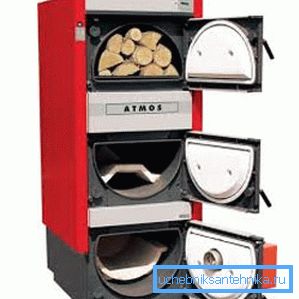
There are also omnivorous boilers that can run on gas, wood, and electricity. By installing such a device in your home, you can switch the burners on your own, depending on the price of fuel and other important factors.
There are also alternative ways of heating homes:
- solar heating collectors;
- wind converters;
- heat pumps.
The listed equipment is either too expensive (capital costs will pay off in 30-40 years), or is still at the stage of engineering testing, so it is not widely used in construction.
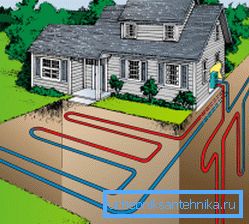
To purchase a boiler of the required model and power, you need to know how many kilowatts you need to heat a house of a certain area. This indicator is calculated using special formulas that take into account many different aspects, but the following table will help to make a rough estimate:
| Heated area | The required amount of heat |
| up to 200 square meters. meters | 25 kW |
| up to 300 square meters. meters | 35 kW |
| up to 600 square meters. meters | 60 kW |
| up to 1200 square meters. meters | 100 kW |
Temperature adjustment in rooms that are heated by a water heating system is made using automatic and manual fittings, which increase and decrease the volume of coolant flowing through the batteries.
Steam heating
First of all, it should be noted that steam heating is practically not used for heating houses due to the complexity and high cost of equipment, as well as the availability of more efficient options.
This heating system on the principle of its work is similar to water, but here the heat energy is transmitted through steam. A powerful boiler boils water, and then the generated steam passes through the pipes and enters the radiators, where it condenses into a liquid state and returns to the heater for a repeated cycle.
There are two types of steam heating systems:
- Open type In this case, the condensation takes place in a tank specially equipped for this, after which the cooled water enters the boiler.
- Closed type. Coolant condensation occurs directly in the pipes.
Speaking about the steam heating system, several points should be noted:
- heating boiler for steam heating is a huge device, occupying more than one square meter;
- all climate network elements must be carefully insulated to avoid burns;
- The main field of application of steam heating is industrial enterprises or commercial buildings, where the generated steam is additionally used in the production process.
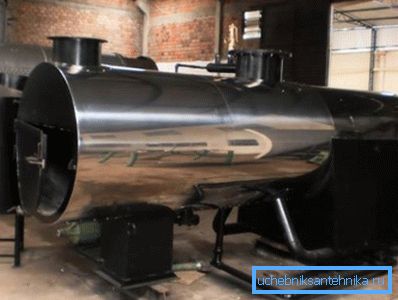
Heated at home with warm air
The air heating system works without heat carrier and is often used to heat summer cottages where people are not expected to live year-round. It saves you from the problems with ice formed in pipes and batteries after the boiler is turned off.
Note! Instead of pipelines in the air-conditioning network, air ducts are used, whose design is more massive. Therefore, it is necessary to provide places for their laying at the stage of development of the project of the future dwelling. In the finished building, installing air ducts is problematic, and more often than not impossible.
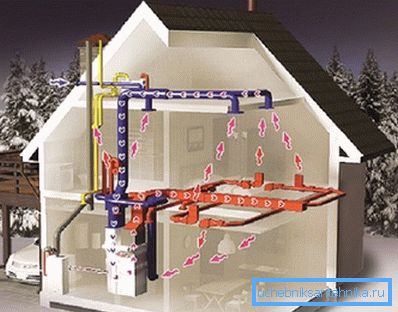
The scheme of work is simple: air is sucked into a special device, where it heats up and enters the rooms through special channels, displacing cold air masses into other vents.
There are two types of air heating:
- With natural circulation - the flow occurs due to the difference in temperature, density and weight of air in the house.
- With forced circulation - used fans with electric motors. This system is more efficient and has low thermal inertia. Within a few minutes after turning on in the house noticeably warmer.
Heat generators for an air heating system are most often powered by electricity, but other energy sources can be used: gas or liquid fuel.
Spot electric heating
In shops of the climatic equipment a large number of electric boilers is on sale. However, this equipment should be attributed to water heating systems, as already mentioned.
On the other hand, there is another class of devices - the so-called point sources of heat.
These include:
- electric convectors;
- oil radiators;
- infrared heaters;
- system "warm floor", powered by electric energy.
The advantages of the above devices are low inertia and ease of installation. A convector or heater should simply be installed in a suitable location and plugged into the network.
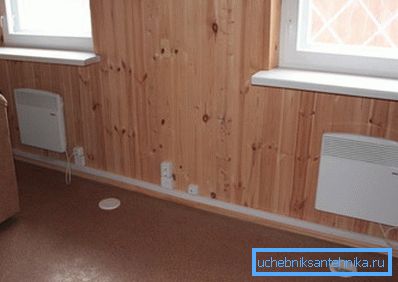
The disadvantages are also obvious - the high cost of paying for electricity and the inability to control the temperature in the house from one control panel. All work parameters are set on each device separately.
Conclusion
Finally, it should be noted that the scheme of the heating network and the types of energy used largely depend on the material from which the house is built, as well as the method of its insulation. For example, heating a house from CIP panels, due to the low thermal conductivity of the material, requires less energy than heating a monolithic concrete structure.
A house of timber, in general, is one of the most energy-efficient solutions. You can learn more about this in the video in this article.